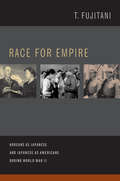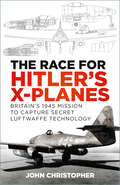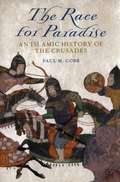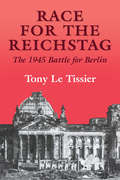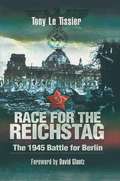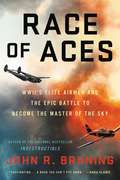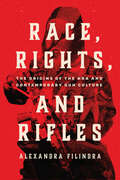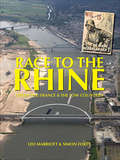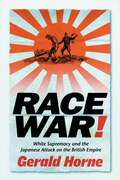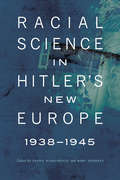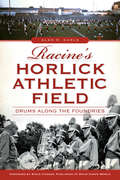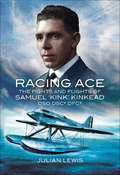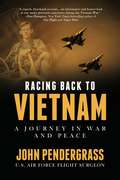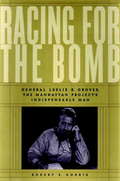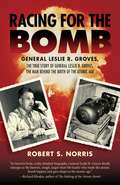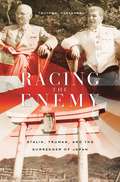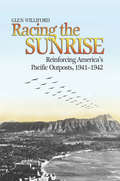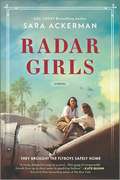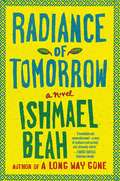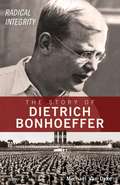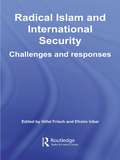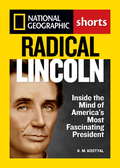- Table View
- List View
Race for Empire: Koreans as Japanese and Japanese as Americans during World War II
by T. FujitaniRace for Empire offers a profound and challenging reinterpretation of nationalism, racism, and wartime mobilization during the Asia-Pacific war. In parallel case studies--of Japanese Americans mobilized to serve in the United States Army and of Koreans recruited or drafted into the Japanese military--T. Fujitani examines the U.S. and Japanese empires as they struggled to manage racialized populations while waging total war. Fujitani probes governmental policies and analyzes representations of these soldiers--on film, in literature, and in archival documents--to reveal how characteristics of racism, nationalism, capitalism, gender politics, and the family changed on both sides. He demonstrates that the United States and Japan became increasingly alike over the course of the war, perhaps most tellingly in their common attempts to disavow racism even as they reproduced it in new ways and forms.
The Race for Hitler's X-Planes: Britain's 1945 Mission to Capture Secret Luftwaffe Technology
by John ChristopherDuring World War 2, Hitler’s engineers had pioneered an incredible array of futuristic secret weapons, from the Me 262, the first operational jet fighter, to the deadly V2 inter continental ballistic missile. With the Third Reich shattered and lying in ruins, in the summer of 1945, the Allies launched a frantic race to grab what they saw as the justifiable spoils of war. The Americans and Russians in particular were anxious to secure not only the aircraft and the research and production facilities, but also the key German scientists and engineers.This Nazi technology would define the balance of power in the phoney peace of the Cold War era, launching an arms race that shaped our modern world for decades to come. But what of Britain’s role in this supermarket sweep? The Race for Hitler’s X-Planes tells the untold story of the British mission to Germany.
The Race for Paradise: An Islamic History of the Crusades
by Paul M. CobbIn The Race for Paradise, Paul M. Cobb offers a new history of the confrontations between Muslims and Franks we now call the "Crusades," one that emphasizes the diversity of Muslim experiences of the European holy war. There is more to the story than Jerusalem, the Templars, Saladin, and the Assassins. Cobb considers the Arab perspective on all shores of the Muslim Mediterranean, from Spain to Syria. In the process, he shows that this is not a straightforward story of warriors and kings clashing in the Holy Land, but a more complicated tale of border-crossers and turncoats; of embassies and merchants; of scholars and spies, all of them seeking to manage a new threat from the barbarian fringes of their ordered world. When seen from the perspective of medieval Muslims, the Crusades emerge as something altogether different from the high-flying rhetoric of the European chronicles: as a cultural encounter to ponder, a diplomatic chess-game to be mastered, a commercial opportunity to be seized, and as so often happened, a political challenge to be exploited by ambitious rulers making canny use of the language of jihad.
Race for the Reichstag: The 1945 Battle for Berlin (Soviet (Russian) Military Experience #No. 4)
by Tony, Le Tissier MBEThe soldiers of the Red Army identified the Reichstag as the victor's prize to be taken in Berlin. This account of the battle lays the many myths created by Soviet propaganda after the event to rest and details what exactly happened as the Red Army and the Allies raced to be the first at the Reichstag.
Race for the Reichstag: The 1945 Battle for Berlin (Soviet (russian) Military Experience Ser. #No. 5)
by Tony Le TissierThe acclaimed historian&’s classic account of the Battle for Berlin offers unprecedented detail and insight into the final days of WWII in Europe. This authoritative study dispels the myths created by Soviet propaganda and describes the Red Army&’s final offensive against Nazi Germany in graphic detail. For the Soviets, Berlin—and the Reichstag in particular—was seen as the ultimate prize. Stalin had initially promised Berlin to Marshal Zhukov. But after Zhukov blundered a preliminary battle, Stalin allowed Marshal Koniev, Zhukov's rival, to launch one of his powerful tank armies at the city. The advancing Soviet forces were confronted by a desperate, inadequate German defense. General Weidling's panzer corps was dragged into the city in a futile attempt to prolong the existence of the Third Reich, whose leaders squabbled and schemed in their underground shelters. Ten days later, after the suicides of Hitler and Goebbels, the survivors had to choose between breakout and surrender. Drawing on a wide range of Soviet sources and unprecedented access to German archival and memoir materials, Race for the Reichstag brings into startling focus the bitter fight for the last patch of soil under Wehrmacht control.
Race of Aces: WWII's Elite Airmen and the Epic Battle to Become the Master of the Sky
by John Bruning<P><P>The astonishing untold story of the WWII airmen who risked it all in the deadly race to become the greatest American fighter pilot. In 1942, America's deadliest fighter pilot, or "ace of aces" -- the legendary Eddie Rickenbacker -- offered a bottle of bourbon to the first U.S. fighter pilot to break his record of twenty-six enemy planes shot down. <P><P>Seizing on the challenge to motivate his men, General George Kenney promoted what they would come to call the "race of aces" as a way of boosting the spirits of his war-weary command. What developed was a wild three-year sprint for fame and glory, and the chance to be called America's greatest fighter pilot. The story has never been told until now. Based on new research and full of revelations, John Bruning's brilliant, original book tells the story of how five American pilots contended for personal glory in the Pacific while leading Kenney's resurgent air force against the most formidable enemy America ever faced. <P><P>The pilots -- Richard Bong, Tommy McGuire, Neel Kearby, Charles MacDonald and Gerald Johnson -- riveted the nation as they contended for Rickenbacker's crown. As their scores mounted, they transformed themselves from farm boys and aspiring dentists into artists of the modern dogfight. But as the race reached its climax, some of the pilots began to see how the spotlight warped their sense of duty. They emerged as leaders, beloved by their men as they chose selfless devotion over national accolades. <P><P>Teeming with action all across the vast Pacific theater, Race of Aces is a fascinating exploration of the boundary between honorable duty, personal glory, and the complex landscape of the human heart.
Race, Rights, and Rifles: The Origins of the NRA and Contemporary Gun Culture (Chicago Studies in American Politics)
by Alexandra FilindraAn eye-opening examination of the ties between American gun culture and white male supremacy from the American Revolution to today. One-third of American adults—approximately 86 million people—own firearms. This is not just for protection or hunting. Although many associate gun-centric ideology with individualist and libertarian traditions in American political culture, Race, Rights, and Rifles shows that it rests on an equally old but different foundation. Instead, Alexandra Frilindra shows that American gun culture can be traced back to the American Revolution when republican notions of civic duty were fused with a belief in white male supremacy and a commitment to maintaining racial and gender hierarchies. Drawing on wide-ranging historical and contemporary evidence, Race, Rights, and Rifles traces how this ideology emerged during the Revolution and became embedded in America’s institutions, from state militias to the National Rifle Association (NRA). Utilizing original survey data, Filindra reveals how many White Americans —including those outside of the NRA’s direct orbit—embrace these beliefs, and as a result, they are more likely than other Americans to value gun rights over voting rights, embrace antidemocratic norms, and justify political violence.
Race to the Rhine: Liberating France and the Low Countries 1944-45 (Then And Now Ser.)
by Simon Forty Leo MarriottTravel across the battlefields of WWII with this beautiful book combining historical images, full-color aerial photography, and informative text.In June, 1944, Allied forces invaded Nazi-occupied France, beginning a sweep of fierce battles that would eventually liberate Western Europe. With aerial photography, historic images, maps, and other illustrations, Race to the Rhine brings readers to the fateful grounds where men sacrificed their lives for freedom.The destruction of German forces in Normandy’s Falaise pocket was a decisive victory: by September, British troops were in Ghent and Liege; Canadian forces liberated Ostend, and in northeast France, Patton’s Third Army was moving rapidly to the German border. The liberation of the Low Countries would not prove as straightforward, however. Operation Market Garden—Montgomery’s brave thrust toward the Rhine at Arnhem—ended in failure with over 6,000 paratroopers captured.In late October, belated operations began to clear the Scheldt Estuary and open the port of Antwerp to the Allies. Belgium was almost free of the Nazi yoke and the Netherlands looked likely to be cleared before Christmas. Then, on December 16, came a major German counter-offensive in the Ardennes. It turned out to be Hitler’s last try: the American defenders held, and in the spring the Rhine was finally gained.Perfect for the armchair traveler or for those who want a historic guide as they visit significant sites, Race to the Rhine supplies essential information on the places that best represent the battles today.
Race War!: White Supremacy and the Japanese Attack on the British Empire
by Gerald HorneJapan's lightning march across Asia during World War II was swift and brutal. Nation after nation fell to Japanese soldiers. How were the Japanese able to justify their occupation of so many Asian nations? And how did they find supporters in countries they subdued and exploited? Race War! delves into submerged and forgotten history to reveal how European racism and colonialism were deftly exploited by the Japanese to create allies among formerly colonized people of color. Through interviews and original archival research on five continents, Gerald Horne shows how race played a key--and hitherto ignored--;role in each phase of the war.During the conflict, the Japanese turned white racism on its head portraying the war as a defense against white domination in the Pacific. We learn about the reverse racial hierarchy practiced by the Japanese internment camps, in which whites were placed at the bottom of the totem pole, under the supervision of Chinese, Korean, and Indian guards--an embarrassing example of racial payback that was downplayed by the defeated Japanese and the humiliated Europeans and Euro-Americans. Focusing on the microcosmic example of Hong Kong but ranging from colonial India to New Zealand and the shores of the U.S., Gerald Horne radically retells the story of the war. From racist U.S. propaganda to Black Nationalist open support of Imperial Japan, information about the effect of race on U.S. and British policy is revealed for the first time. This revisionist account of the war draws connections between General Tojo, Malaysian freedom fighters, and Elijah Muhammed of the Nation of Islam and shows how white racism encouraged and enabled Japanese imperialism. In sum, Horne demonstrates that the retreat of white supremacy was not only driven by the impact of the Cold War and the energized militancy of Africans and African-Americans but by the impact of the Pacific War as well, as a chastened U.S. and U.K. moved vigorously after this conflict to remove the conditions that made Japan's success possible.
Rachel's Secret: an engrossing and heartwarming novel of friendship and the bonds which tie us together from bestselling author Susan Sallis
by Susan SallisFrom the pen of multi-million copy seller and Sunday Times bestselling author Susan Sallis comes beautifully written, enthralling and captivating novel that asks whether friendships really can endure through thick and thin. Readers of Rosamunde Pilcher, Maeve Binchy and Fiona Valpy will not be disappointed.'Sallis's West Country novel has the feel of Mary Wesley and character insight that is all her own' -- Daily Mail'Sallis brings out the innate warmth and sometimes unpredictability of the human psyche. This compelling tale will not disappoint' -- Lancashire Evening Post'Excellent read, very enjoyable' - ***** Reader review'Wonderful' - ***** Reader review'I love her books and the way that she takes you right into the story...You can tell I am a big fan!' - ***** Reader review'Brilliant, I couldn't put it down.' - ***** Reader review*********************************************************************FRIENDS SINCE CHILDHOOD, THEY THOUGHT NOTHING COULD COME BETWEEN THEM...1943: two schoolgirls, Rachel and Meriel, best friends, amuse themselves by tracking down imaginary German spies. It all seems a harmless way of whiling away the long school holidays, until their game turns into a frightening reality, the consequences of which affect their whole lives.Rachel becomes a reporter on the local paper while Meriel, a GI bride, goes to live in Florida.But the bonds which hold them together can never be broken, as the secrets and scandals which first surfaced in those far-off wartime days eventually come to light.
Racial Science in Hitler's New Europe, 1938-1945 (Critical Studies in the History of Anthropology)
by Anton Weiss-WendtIn Racial Science in Hitler&’s New Europe, 1938–1945, international scholars examine the theories of race that informed the legal, political, and social policies aimed against ethnic minorities in Nazi-dominated Europe. The essays explicate how racial science, preexisting racist sentiments, and pseudoscientific theories of race that were preeminent in interwar Europe ultimately facilitated Nazi racial designs for a &“New Europe.&”The volume examines racial theories in a number of European nation-states in order to understand racial thinking at large, the origins of the Holocaust, and the history of ethnic discrimination in each of those countries. The essays, by uncovering neglected layers of complexity, diversity, and nuance, demonstrate how local discourse on race paralleled Nazi racial theory but had unique nationalist intellectual traditions of racial thought. Written by rising scholars who are new to English-language audiences, this work examines the scientific foundations that central, eastern, northern, and southern European countries laid for ethnic discrimination, the attempted annihilation of Jews, and the elimination of other so-called inferior peoples.
Racine's Horlick Athletic Field: Drums Along the Foundries (Landmarks)
by Alan R. KarlsLaunched in 1919 by William Horlick, the inventor of malted milk, Horlick Athletic Field has hosted two NFL teams, the Racine Belles professional women's baseball team (immortalized in "A League of Their Own)" and thousands of semiprofessional- and industrial-league games. But it is the drum and bugle corps shows that have made the stadium one of the most iconic landmarks in its corner of the state. From an archive of fond recollection and painstaking record, Alan Karls has pieced together a history of Horlick Athletic Field that justifies the reverence that drum and bugle corps have felt for the place for almost a century.
Racing Ace: The Fights and Flights of 'Kink' Kinkead DSO, DSC*, DFC*
by Julian LewisSamuel Kink Kinkead won two DSCs with the Royal Naval Air Service, two DFC with the fledgling RAF and the DSO in Russia.A brilliant pilot, postwar he was a long range aviation pioneer and leading racing ace selected for the international Schneider Trophy in Venice in 1927. Tragically, he was killed in 1928 when he was only 31 during his attempt to shatter the World Air Speed record. He is honored by several memorials, at Cranwell, the RAF Club in Piccadilly, at Fawley and a permanent exhibition in the Kinkead Room at Calshot from where he set out on his final flight.Julian Lewis MP has pieced together Kinks extraordinary story of achievement during his short but eventful and glamorous life. A fascinating account of flying derring-do in war and peace.
Racing Back to Vietnam: A Journey in War and Peace
by John PendergrassIn 1971, United Air Force flight surgeon John Pendergrass spent much of his time in the backseat of an F-4 Phantom, racing across the skies of Vietnam. Forty-five years later, he boards an altogether different type of aircraft and heads back to Vietnam for an altogether different kind of race—an IRONMAN® triathlon. A veteran of IRONMAN triathlons on six continents, Racing Back to Vietnam follows John’s year in combat and his return to Vietnam, revisiting a country that, for him, is bound up in history, memory and emotion. A memoir of war as seen from the skies and a reflection on life’s high adventure, John tries to reconcile the Vietnam he saw from the backseat of a fighter jet with today’s modern Vietnam. Thought-provoking, heartfelt and gripping, Racing Back to Vietnam is one man’s trip back through time on a journey of rediscovery.
Racing for the Bomb: General Leslie R. Groves, the Manhattan Project's Indispensable Man
by Robert S. NorrisNorris (research associate, Natural Resources Defense Council) celebrates the life of General Groves (1896-1970), whom he considers to have the dubious distinction of being the indispensable person in the building of the atomic bomb and the critical person in determining how, when, and where it was used in Japan. Despite the book's title, a significant amount of the material focuses on Groves' youth, education, and early career before he was tapped to head the Manhattan project. Further material discusses his later involvement with the politics of nuclear arms after the close of World War II. Groves' overwhelming influence in the Manhattan project, Norris feels, was also instrumental in building the national security state that has continued to characterize the post-war years. Annotation c. Book News, Inc. , Portland, OR (booknews. com)
Racing for the Bomb: The True Story of General Leslie R. Groves, the Man behind the Birth of the Atomic Age
by Robert S. NorrisIn September 1942, Colonel Leslie R. Groves was given the job of building the atomic bomb. As a career officer in the Army Corps of Engineers, Groves had overseen hundreds of military construction projects, including the Pentagon. Until now, scientists have received the credit for the Manhattan Project's remarkable achievements. And yet, it was Leslie R. Groves who made things happen. It was Groves who drove manufacturers, construction crews, scientists, industrialists, and military and civilian officials to come up with the money, the materials, and the plans to solve thousands of problems and build the bomb in only two years. It was his operation, and in Racing for the Bomb he emerges as a take-charge, can-do figure who succeeds in the face of formidable odds.Revealed for the first time in Racing for the Bomb, Groves played a crucial and decisive role in the planning, timing, and targeting of the Hiroshima and Nagasaki missions. Norris offers new insights into the complex and controversial questions surrounding the decision to drop the bomb in Japan and Groves's actions during World War II, which had a lasting imprint on the nuclear age and the Cold War that followed.Grove's extensive influence on key institutions of postwar America has been overlooked for too long. In this full-scale biography, which includes archival material and family letters and documents and features several previously unpublished photographs, Norris places Groves at the center of the amazing Manhattan Project story.
Racing the Enemy: Stalin, Truman, and the Surrender of Japan
by Tsuyoshi HasegawaWith startling revelations, Tsuyoshi Hasegawa rewrites the standard history of the end of World War II in the Pacific. By fully integrating the three key actors in the story--the United States, the Soviet Union, and Japan--Hasegawa for the first time puts the last months of the war into international perspective. From April 1945, when Stalin broke the Soviet-Japanese Neutrality Pact and Harry Truman assumed the presidency, to the final Soviet military actions against Japan, Hasegawa brings to light the real reasons Japan surrendered. From Washington to Moscow to Tokyo and back again, he shows us a high-stakes diplomatic game as Truman and Stalin sought to outmaneuver each other in forcing Japan's surrender; as Stalin dangled mediation offers to Japan while secretly preparing to fight in the Pacific; as Tokyo peace advocates desperately tried to stave off a war party determined to mount a last-ditch defense; and as the Americans struggled to balance their competing interests of ending the war with Japan and preventing the Soviets from expanding into the Pacific. Authoritative and engrossing, Racing the Enemy puts the final days of World War II into a whole new light.
Racing the Enemy: Stalin, Truman, and the Surrender of Japan
by Tsuyoshi HasegawaWith startling revelations, Tsuyoshi Hasegawa rewrites the standard history of the end of World War II in the Pacific. By fully integrating the three key actors in the story--the United States, the Soviet Union, and Japan--Hasegawa for the first time puts the last months of the war into international perspective. From April 1945, when Stalin broke the Soviet-Japanese Neutrality Pact and Harry Truman assumed the presidency, to the final Soviet military actions against Japan, Hasegawa brings to light the real reasons Japan surrendered. From Washington to Moscow to Tokyo and back again, he shows us a high-stakes diplomatic game as Truman and Stalin sought to outmaneuver each other in forcing Japan's surrender; as Stalin dangled mediation offers to Japan while secretly preparing to fight in the Pacific; as Tokyo peace advocates desperately tried to stave off a war party determined to mount a last-ditch defense; and as the Americans struggled to balance their competing interests of ending the war with Japan and preventing the Soviets from expanding into the Pacific. Authoritative and engrossing, Racing the Enemy puts the final days of World War II into a whole new light.
Racing the Sunrise
by Glen M. WillifordGlen Williford lends new insight into the reasons for America s relatively quick comeback from the attack on Pearl Harbor. For the first time, he tells the complete story of American efforts to build and reinforce its Pacific garrisons in the Philippines and Hawaii during the six months prior to the war and to supply Bataan and Corregidor in early 1942. One effort involved a carefully organized convoy and air ferry routes that were reaching their heights in December 1941. The author fully describes the reinforcement efforts in the context of both the existing military strategies and the realities and physical limits of America s defense capabilities at the time. It concludes with an examination of the transition from the desperate defensive efforts to protect lines of communication to Australia and build a major base there to using these assets to resume the offensive.
Radar Girls: a novel of WWII
by Sara Ackerman"A fresh, delightful romp of a novel."—Kate Quinn, New York Times bestselling author of The Rose Code* SheReads Most Anticipated Historical Fiction of Summer 2021 pick * Book Reporter Summer Reading pick * BiblioLifestyle Most Anticipated Summer 2021 Historical Fiction Books selection * Greatist Best Historical Fiction Books pick * An extraordinary story inspired by the real Women&’s Air Raid Defense, where an unlikely recruit and her sisters-in-arms forge their place in WWII history.Daisy Wilder prefers the company of horses to people, bare feet and salt water to high heels and society parties. Then, in the dizzying aftermath of the attack on Pearl Harbor, Daisy enlists in a top secret program, replacing male soldiers in a war zone for the first time. Under fear of imminent invasion, the WARDs guide pilots into blacked-out airstrips and track unidentified planes across Pacific skies. But not everyone thinks the women are up to the job, and the new recruits must rise above their differences and work side by side despite the resistance and heartache they meet along the way. With America&’s future on the line, Daisy is determined to prove herself worthy. And with the man she&’s falling for out on the front lines, she cannot fail.From radar towers on remote mountaintops to flooded bomb shelters, she&’ll need her new team when the stakes are highest. Because the most important battles are fought—and won—together.This inspiring and uplifting tale of pioneering, unsung heroines vividly transports the reader to wartime Hawaii, where one woman&’s call to duty leads her to find courage, strength and sisterhood. &“A wow of a book…[that is] a captivating story of friendship, heartbreak and true love. Highly recommend!&” —Karen Robards, New York Times bestselling author of The Black Swan of Paris
Radiance of Tomorrow: A Novel
by Ishmael BeahA haunting, beautiful first novel by the bestselling author of A Long Way Gone Now Beah, whom Dave Eggers has called "arguably the most read African writer in contemporary literature," has returned with his first novel, an affecting, tender parable about postwar life in Sierra Leone. At the center of Radiance of Tomorrow are Benjamin and Bockarie, two longtime friends who return to their hometown, Imperi, after the civil war. The village is in ruins, the ground covered in bones. As more villagers begin to come back, Benjamin and Bockarie try to forge a new community by taking up their former posts as teachers, but they're beset by obstacles: a scarcity of food; a rash of murders, thievery, rape, and retaliation; and the depredations of a foreign mining company intent on sullying the town's water supply and blocking its paths with electric wires. As Benjamin and Bockarie search for a way to restore order, they're forced to reckon with the uncertainty of their past and future alike. With the gentle lyricism of a dream and the moral clarity of a fable, Radiance of Tomorrow is a powerful novel about preserving what means the most to us, even in uncertain times.
Radical Integrity: The Story of Dietrich Bonhoeffer
by Michael Van DykeYou'll be inspired by this story of a German pastor and theologian who gave his life to oppose Adolf Hitler and his Nazi regime. Born into a prominent German family, Dietrich Bonhoeffer died in a Nazi prison camp, hanged for his plot against the man who'd plunged the world into war. Find out what made Dietrich Bonhoeffer the man he was--compassionate minister, brilliant thinker, opponent of the heresies of Nazism and Aryan superiority. This easy-to-read biography details both Bonhoeffer's life and his powerful theology--of "cheap" versus "costly" grace.
Radical Islam and International Security: Challenges and Responses
by Hillel Frisch Efraim InbarRadical Islam poses a political challenge in the modern world which is like that of no other radical religious movement. Ideologically, it is perceived by Western policy makers as threatening the liberal-democratic ideology by which most states in the West abide and which most other states rhetorically espouse. This book serves as a welcome addition to the intellectual and policy debate on the nature of the radical Islam phenomenon and how to respond to it. The collection is divided into three parts: the first part seeks to understand the Islamic challenge in broad comparative and historical terms, while the second part deals with specific regional case studies, which seek to identify patterns of uniformity and variation in radical Islam across a wide swath of terrain. The third part is policy-oriented, suggesting possible responses to the Islamic challenge. The contributors include distinguished researchers from Europe, North America and the Middle East. This book will be of much interest to students of Islamism, political violence, international security and Middle Eastern politics.
Radical Islam in East Africa
by Angel RabasaAmerican geopolitical interests and the potential threats to those interests are both on the rise in East Africa. The author places the spread of militant Islamism and the development of radical Islamist networks in East Africa in the broader context of the social, economic, and political factors that have shaped the region's security environment.
Radical Lincoln: Inside the Mind of America's Most Fascinating President
by K. M. KostyalHe has more books written about him than any other President of the United States but what do we really know about the man himself? There are a handful of facts: he was from the frontier, was raised in a poor farmer family, had a passion for learning, was quiet, and a skeptic. Millions of words have been spilled over the details of his life. But who was the real Lincoln? In this daring ebook short, K. M. Kostyal uses the facts of Lincoln's early life to build a psychological profile of the man who would change the course of history. She examines his early life to understand how this bright frontier lawyer would come to lead a nation, noting especially the dramatic influence of Lincoln's hard-driving father and his brilliant, political, and often misunderstood wife Mary in challenging him to reach for the highest office in the United States. She further looks at just how such a brilliant political mind was able to maintain his connection to simple country folk, and how that connection has amplified over the decades so that the 'cult of Lincoln' that only grows larger with each passing year. Bringing fresh insights and a brilliant grasp of history to one of history's most enigmatic characters, Kostyal paints a compulsively readable portrait that will be a popular read for years to come.
